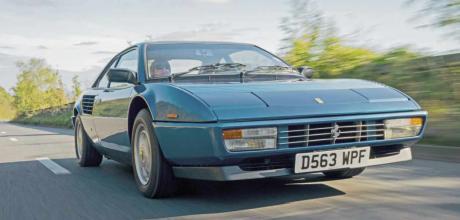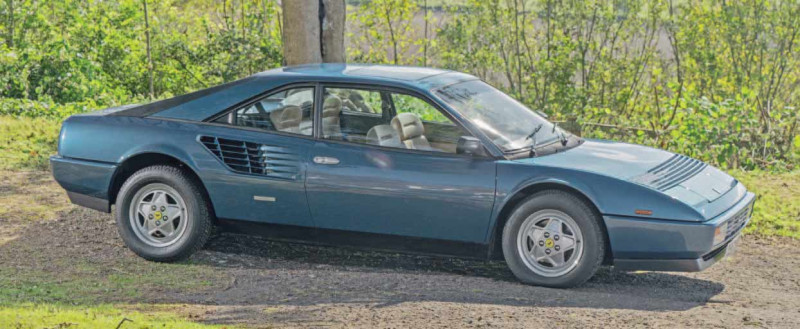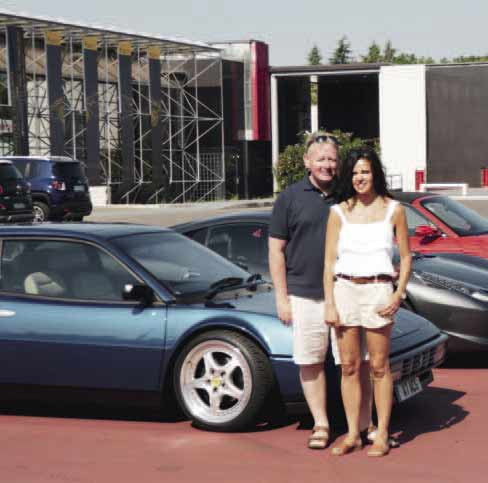Buyers Guide Ferrari Mondial

Buy a Ferrari for Mondeo money’ screamed the headlines in the car magazines of 20 years ago. They’d latched on to the fact that for the same money as a new family hatch, you could put a classic Ferrari in your garage. It was usually the 308 GT4 that they featured, or perhaps the 365/400/412, if not the other generally unloved Ferrari 2+2, the Mondial. In the minds of many marque enthusiasts, a Ferrari shouldn’t have more than two seats because let’s face it, the styling is invariably a bit compromised as a result.
FERRARI MONDIAL: BUYING MARANELLO’S MID-ENGINED MARVEL
BUYING FERRARI MONDIAL
Only you can decide whether or not the Mondial’s design works, but what we can tell you is that this is a mid-engined Ferrari with V8 power, and it’s a classic that the whole family can enjoy. It’s also one of the most affordable routes into Ferrari ownership, you can do much of the maintenance on a DIY basis, and if the chassis is set up properly, the Mondial is also terrific fun to drive. Buy a cabriolet and you’ll own an example of the world’s only volume-built mid-engined four-seater soft-top. What’s not to like? Apart from the potentially ruinous running costs that is…

Which one?
Each iteration of the Mondial is quite different from the others. The original take on the formula, the Mondial 8, is underwhelming thanks to its lack of power and generous kerb weight. But you’re unlikely to find one of these as few were sold here, and most have been broken by now.

The Mondial QV is far better, as it feels much more perky and agile, the build quality is much better and there are more to choose from. The Mondial 3.2 is better again, as it has a few more horses and its refreshed design is noticeably cleaner inside and out. All of these earlier models, which account for almost the first decade of production, feature a longitudinally mounted engine and transmission that’s mounted on a rear subframe, along with the rear suspension. The subframe can be relatively easily removed for maintenance, but the Mondial t has a completely different arrangement, with a transversely mounted dry-sump V8 (it’s Mondial t for transverse), and maintenance is significantly more costly as a result.
The most appealing thing about the Mondial t for most owners, is that it’s much better to drive than its predecessors thanks to a lower centre of gravity, courtesy of that completely different mechanical arrangement; it also came with power steering as standard. Compared with the 8, QV and 3.2, it’s immediately apparent that the t is set up much better for keen drivers. It’s also by far the quickest of the bunch; 0-60mph takes just 5.6 seconds, whereas it was closer to 10 seconds for the Mondial 8; the QV slashed this to well under seven seconds, however.
Most Mondials are coupés, but the cabriolet is worth seeking out because it’s a true family car (if your kids are small), that’s open to the elements so you can really enjoy that glorious V8 soundtrack.
What to look for: bodywork
The Mondial may be one of the least valuable Ferraris, but most of these cars are pampered. In the main they’re used sparingly by owners who dote on them, so they’re usually in good condition, but beware of cars being sold because a big bill is about to hit. Serious corrosion isn’t normally an issue, but localised rust can crop up in the front and rear wheelarches, along with the sills and door bottoms. On the Mondial 8 and QV there was a black plastic strip that ran around the rear edge of the roof and down the flying buttresses; repairs cost £500 per side for replacement mouldings. Home in on the lower section of the front wings, between the wheelarch and A-post, as corrosion is common here. The alloy door mirrors corrode on their underside and new ones cost £300 each.
All of the Mondial’s structure is steel, although the floorpans are made from glassfibre. The bonnet, boot lid and engine cover are made of aluminium, as is the undertray. Later Mondials had a galvanised bodyshell, but that doesn’t always offer the protection that you might expect because corrosion can still break out.
Parts availability is poor when it comes to panels, so any Mondial with significant rust means fabricating lots of new bits from scratch. This includes the tubular steel chassis, which needs to be checked thoroughly, but anything other than very localised corrosion suggests that the car has been very harshly treated, in which case plenty of other big problems will also be evident. The curved rear screen is heated and the elements corrode leading to the glass delaminating (going milky). The only solution is replacement but they’re unavailable, unless you invest in getting a batch remade through someone such as Pilkington Classics. So you don’t get the same problem in the future you could get them remade without any heating element.
The V8 is strong if properly maintained, which is why evidence of regular servicing is so important. The 3.0-litre engine was shared with the 308, the 3.2-litre unit with the 328 and the 3.4-litre unit was the same unit as the one found in the 348. As such, parts availability is excellent, although nothing is cheap when it comes to servicing or rebuilds.
The Ferrari Owners’ Club runs a circuit racing series for classic tipos, with the 308, 328 and Mondial all popular with entrants because of the inherent strength of the V8. A 3.4-litre Mondial V8 will easily rack up 150,000 miles or more between rebuilds, if looked after, although the 3.0-litre engine typically gives closer to 100,000 miles before serious attention is required. Neglected Mondials are out there, and if you buy one that needs an engine rebuild, that’ll come with a bill of not less than £10,000, which is why doing your homework is so crucial.
Every three years the cambelts need to be replaced, and with the Mondial t this is a £2000 engine-out job. But where the earlier cars are concerned, the cost is cut by about two-thirds, because the work can be done with the engine in place.
There are rubber pipes that run from the radiator in the nose to the engine towards the back. These perish and they’re a pain to replace because they run through the chassis, plus they swell over time. Fitting silicone replacements is a good investment as they last a lot longer.
Most Mondials came with a five-speed manual gearbox which is very strong and it rarely gives problems. The gear linkage (that goes through the engine to the gearbox) tends to leak, and replacing the seal takes several hours. Better aftermarket seals are available.
Expect baulking aplenty when trying to go into second when cold (synthetic oil helps here), but once warmed up the gearchange should be sweet and the clutch light. On that note, it’s quicker and easier to change a clutch on the t than on earlier models; clutches generally last 30,000-40,000 miles. It’s at this point that you might fall out of love with your Mondial because there’s no escaping the high parts costs. A genuine clutch (including a release bearing) costs £475 from Superformance; a Mondial t item is £1770 plus £375 for the release bearing. The labour is typically £400 to fit a Mondial t clutch, but closer to £600 for the earlier models.
For the final year of production, Ferrari introduced a clutchless-manual semi-automatic transmission made by Valeo. Essentially a forerunner to the F1 transmissions that would come later, the Valeo gearbox has a manual gearshift but no clutch pedal. It’s an incredibly rare transmission and it’s best avoided anyway because of poor parts availability, it’s not very nice to use, and it doesn’t have a great reliability record.
In good condition a Mondial should be a joy to drive, but there’s always going to be a gradual deterioration as the springs, dampers and bushes wear out. Replacing just the bushes will usually transform a Mondial’s dynamics and for this you need to budget about £3000. Overhaul the suspension at the same time, and by the time you’ve replaced the springs and dampers and done some cleaning up along with some powder coating, the bill will soon escalate to more like £10,000.
The Mondial t came with adjustable dampers, with three settings which can be selected via a switch on the dashboard. The difference between the three settings isn’t all that stark, but in the firmest mode everything stiffens up that little bit more. There’s a warning light on the dash that lets you know all is well with the system; it should go out after a few seconds. If it doesn’t come on at all, or it fails to go out, something is clearly amiss. The adjustable dampers can be rebuilt for around £500 apiece, while the motors that control them have to be replaced, at about £800 per corner.
Only the Mondial t was fitted with imperial tyres; earlier editions got metric 390mm Michelin TRXs which cost upwards of £400 apiece, when available. Many owners switch to imperial wheels (Superformance does a set for £895) to take 16” Goodyear tyres at about £450 per set of four. Other options include fitting 348 or Mondial t alloys.
There’s nothing especially to worry about with the brakes; some parts are shared with contemporary mass-produced cars, so prices tend to be reasonable. From 1987 the Mondial was fitted with anti-lock brakes which is given away by the convex wheels, whereas earlier Mondials had concave alloys.
All Mondials came with leather trim, although some earlier models had cloth inserts in the seats. It tends to wear well, although after 50,000 miles the hide can get a bit baggy. There’s nothing that’ll faze a competent trimmer, but if the cabin is really scruffy it can easily cost £10,000 to get everything looking good again. Some localised repairs are more likely to be all that’s needed though, at more like £2000-£3000.
Electric windows and air conditioning were fitted to all Mondials. Both can give problems, but it’s all fixable at a price. The biggest bill that you’re likely to face is for a new air-con compressor, which will be around £1000 by the time it’s fitted. A key problem is that the Freon (R12) gas that was used when the Mondial was new, is now illegal to use so you have to switch to R134a instead. This leaks from the pipes because they’re not suitable, and fitting R134a-friendly parts can run into thousands. So you either have to do without aircon (and the cabin gets hot), you have to do as much of the work yourself as you can, you have to regas regularly, or you have to bite the bullet and cough up to get the job done properly.
If you buy a coupé with an electric sliding steel sunroof, repairs can be significantly more costly. The gears wear out and the cables seize up, so you either need to keep the roof shut permanently (which guarantees that everything will seize up), or you have to bite the bullet and pay to get everything working properly, and that can run into thousands…
Finally, don’t under-estimate the cost of fixing seemingly small things such as damaged lights along with missing bits of interior or exterior trim. Not everything is available and when it is, purchase costs can be inordinately high.
The market
The newer a Mondial, the more it’s worth. Find a scruffy Mondial 8 and you’ll pay as little as £25,000 for it, but it’s likely to need a steady stream of expenditure on the mechanicals and bodywork and it’ll end up costing you plenty. Remember, the most expensive Ferrari is a cheap one, whatever the tipo. You’re much better off spending closer to £30,000 for a tidy Mondial 8, if you’re keen to have one of these earliest iterations of the breed. Find a superb Mondial 8 and you could pay around £35,000 for it, but for much the same money you could buy a QV or 3.2. Good examples of these start at £35,000, while something really nice is closer to £40,000. Find an exceptional low-mileage car in tip-top condition and you could pay £45,000 for it, but such cars very rarely crop up.
The Mondial t is the most valuable edition of all, and for something worth owning you’ll pay at least £40,000, with really nice examples closer to £45,000. Cabriolets fetch a few thousand pounds more, so expect to pay £50,000 for a superb open-topped Mondial t, with the very best low-mileage examples worth £55,000.
Values are mileage sensitive up to a point, but don’t get too hung up on what the odometer is showing. What really matters is the service history and how much cash has been lavished on the car in recent years. Splash out on a major service plus a bit of remedial work on the bodywork and running gear, and it’s easy to rack up a £10,000 bill, if the previous owner was in the habit of skimping. That’s why finding a car that’s been pampered is so important. On that note, don’t stretch yourself to buy a Mondial, because if you don’t have a contingency fund of a few thousand quid, there’s a good chance you’ll come unstuck. Unless you can do most of the maintenance yourself – and that’ll have a knock-on effect on the car’s resale value – you’ll need to budget to spend at least £2000 per year on average. Some years it’ll be a lot less, but the occasional big bill is part and parcel of Ferrari ownership.
| Vital statistics | Mondial 8 | Mondial QV | Mondial 3.2 | Mondial t | Mondial t cabriolet |
| Engine | 2927cc/V8 | 2927cc/V8 | 3186cc/V8 | 3404cc/V8 | 3404cc/V8 |
| Power (bhp@rpm) | 214@6600 | 240@7000 | 270@7000 | 300@7000 | 300@7000 |
| Torque (lb/ft@rpm) | 179@4600 | 191@5000 | 224@5500 | 239@4200 | 239@4200 |
| Top speed (mph) | 144 | 150 | 155 | 160 | 160 |
| 0-60mph (seconds) | 9.1 | 7.8 | 7.4 | 6.3 | 6.3 |
| Consumption (mpg) | 22 | 20 | 20 | 19 | 19 |
| Gearbox | 5-speed manual | 5-speed manual | 5-speed manual | 5-sp man/semi-auto | 5-sp man/semi-auto |
| Length (mm) | 4580 | 4580 | 4535 | 4535 | 4535 |
| Width (mm) | 1790 | 1790 | 1795 | 1810 | 1810 |
| Height (mm) | 1250 | 1250 | 1235 | 1235 | 1265 |
| Weight (kg) | 1585 | 1430 | 1410 | 1426 | 1468 |


